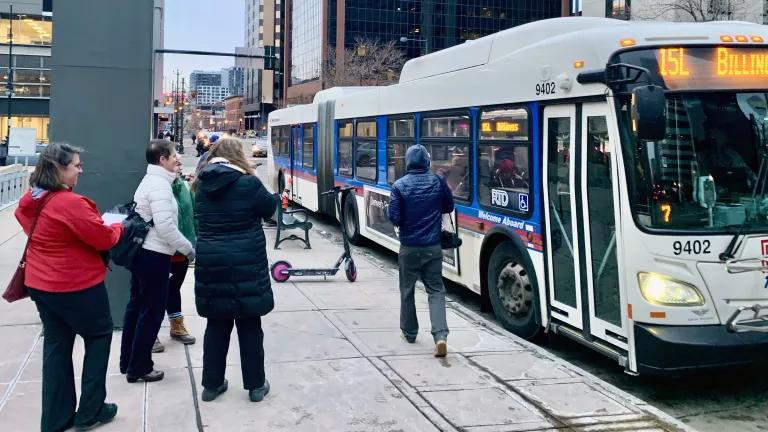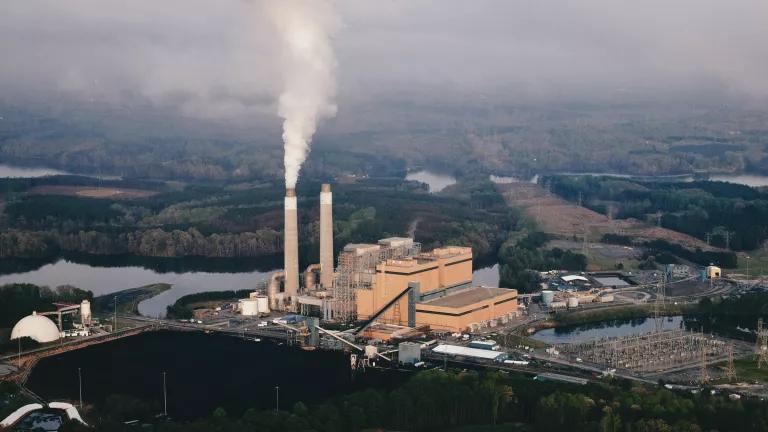The Climate Crisis Requires That We Move Away from Gas

Natural (or “fossil”) gas, so long thought of by many as a bridge fuel to a clean energy future, needs to be replaced as fast as possible with cleaner, no-emissions solutions, given the climate crisis facing us.
The question we must ask: How do we reach a no-carbon future at least cost and to the benefit of the workers and communities relying on gas today? The answer becomes even more urgent as we learn more about the catastrophe that awaits us if we can’t wean ourselves from all fossil fuels, including gas.
We must get to zero or net-zero emissions as fast as possible.
Climate protection requires us to act; renewables and efficiency make it possible
There was support for increased reliance on gas years ago to replace dirtier fuels like coal and oil, and because cleaner alternatives weren’t quite ready to fill the gap. But the situation has rapidly changed, and now it is time to reduce our dependence on gas and decarbonize what remains. This is possible because:
- Opportunities for smarter energy use abound everywhere, with electric technologies like heat pumps now outperforming less-efficient gas appliances and equipment;
- Renewable generation, like wind and solar, has come down in cost so much and so fast these energy resources are now cheaper than fossil fuel generation in most parts of the country; and
- Technologies like battery storage and distributed (locally generated) energy resources can help enhance grid reliability and flexibility, even with high levels of renewable resources that are intermittently available.
But gas is still expanding rapidly
Gas power plants (which currently operate without carbon capture and storage) are now the top source for U.S. electricity generation—outpacing coal—and unless we act now, are expected to remain the largest source of power for the next few decades. Gas also is used directly in homes and businesses to heat water and spaces. Unfortunately, the United States is still building new gas distribution lines to displace dirtier fuel oil, despite the availability of more efficient, clean, and electric heating technologies to replace it instead.
At the same time, domestic gas production is growing at a record rate even though America doesn’t need all this new gas to meet the electricity and heating needs of our homes and businesses. Nonetheless, the gas industry is investing in and developing massive and long-lived (40 to 60 years) gas infrastructure projects—such as new liquified natural gas (LNG) export terminals, pipelines, and power plants—to find new markets for the fast-growing supply of fracked gas and to increase producers’ profits. These are long-term, expensive investments that have a good chance of becoming uncompetitive, or economically “stranded,” since there are much cleaner, cost-competitive (or soon to be) alternatives to reach our climate goals. That means we will still be paying for these investments long after they are no longer economically or environmentally viable, resulting in higher energy bills, lost jobs, and financially unstable utilities.
Why gas is not a long-term solution
Gas has helped the country transition away from coal and petroleum, and it contributed to a reduction in power sector carbon pollution alongside no-emissions energy efficiency and renewable generation. Many local distribution utilities that provide gas to our homes and businesses have also been good, decades-long partners in supporting energy efficiency programs and efficiency standards to reduce their customers’ energy consumption. But gas is not a clean fuel. Power generation and industry will have to be equipped with carbon capture and storage to make any remaining gas use compatible with carbon reduction targets. And even then, the drilling and fracking of gas represents a number of climate and public health risks.
The production, transportation, and combustion of gas poses a myriad of problems for clean air, clean water, wildlife, landscapes and ecosystems, human health, local communities, and our climate. Leaking gas infrastructure is a source of unaddressed climate and harmful air emissions and can create emissions hotspots, significant public human health impacts, and environmental justice issues because it is often located in disadvantaged areas.
Gas may be the least polluting fossil fuel, but it still emits significant amounts of carbon, and leaks from its production and transportation significantly increase its carbon footprint since methane is a potent greenhouse gas. Put them together, and it’s clear that we must cut gas use dramatically and bring remaining emissions to zero.

How do we reduce our reliance, smartly?
We need to create a zero- or net-zero carbon future to deal with the worsening climate crisis—and that requires transitioning away from fossil gas. Getting there will require us to significantly reduce our reliance on gas and, for any gas we still use, address both the methane leaked throughout the supply chain and carbon emitted during combustion. Moving away from gas—in our buildings, in the power sector, and across our economy—could take a long time, and that is why we must start now. Here are some things we can do today to get there smartly and affordably:
- State public utility commissions and customer-owned utility boards must require investment in cleaner, more efficient, and affordable alternatives—like energy efficiency, demand response, and renewable energy—to gas power plant investments. And any new gas plants that are built must apply carbon capture and storage.
- The Federal Energy Regulatory Commission (FERC) must implement a more robust gas pipeline and LNG facility review process that seriously looks at the need for new pipelines and the climate pollution impacts. (FERC gas pipeline approvals since 1999 have provided the United States enough pipeline capacity to carry over 227 billion cubic feet of natural gas every day, but average daily U.S. consumption was just 106.8 billion cubic feet last year and the peak-day consumption record is 145.9 billion cubic feet a day, set during the January Polar Vortex this year). Yet FERC is still approving almost every pipeline it reviews!
- The government should stop trying to roll back federal rules requiring gas producers to capture the substantial quantities of methane emitted during production, processing, transmission, and storage. These attempts gravely undermine the carbon reductions that gas has historically provided by displacing coal. This matters because as a greenhouse gas, methane is as much as 87 times more potent than carbon dioxide in the near term, and methane releases alone are estimated to represent one-sixth of total climate emissions.
- The nation’s transmission system operators must change the capacity market rules that contribute to an over-reliance on gas instead of clean energy alternatives. (As is happening in the nation’s largest regional grid system—PJM—where gas plants are proliferating due to a combination of cheap Marcellus Shale and flawed market rules.)
- State and local regulators should be evaluating the need for, and alternatives to, new investments in gas distribution infrastructure. They should require local gas distribution companies to take a different approach to their system planning and consider clean, non-pipeline investments like energy efficiency, electric heating and cooling systems, and other cost-effective solutions that can help reduce the need to build new, or replace aging gas infrastructure. This is needed in addition to setting federal climate and clean energy standards.
- Effective integration of all types of energy storage (from electric vehicles to long-duration storage) and other flexible ways to meet our energy needs (like efficiency and demand response), and a more balanced, modern grid can meet most (but not all) of our renewable integration needs and significantly reduce the need for new gas plants.
- Alternatives must be developed to displace any gas that we cannot avoid even if we increase efficiency and beneficial electrification. They might include biomethane (gas made from biological sources); power to gas (or hydrogen) produced from electricity sources; and carbon capture and sequestration at gas power plants and industrial sites. Such alternatives are likely to be more expensive and/or constrained by supply, and should be focused on the hardest to decarbonize sectors, such as heavy-duty transportation, aviation, and industry—as well as other uses for which there are currently no good substitutes.
- The gross economic and structural incentives that perversely incent the leasing and drilling of natural gas across tens of millions of acres of our nation’s public lands and waters must be remedied. There is no equity in a system in which a solar or wind producer is charged thousands of dollars per acre for the privilege to lease federal lands, but a gas producer only pays between $1.50 to $2 an acre to operate on essentially the same public lands.
- The true costs that occur from drilling on our nation’s public lands and waters should also not go unchecked. For instance, the Interior Department continues to defy federal statute that requires gas producers to account for the climate impacts associated with gas drilling and fracking on federal lands. Further compounding matters are the inadequate and outdated regulations that govern hydraulic fracturing and the Trump administration rollback of the bare-bones federal rules that did exist. Loopholes and exemptions in our bedrock environmental laws—including the Clean Air Act, the Clean Water Act, and the Safe Drinking Water Act—create an unfair advantage for gas producers and are fundamentally harmful.
- We need to ensure that our workforce and communities are not left behind in the transition. Protection of vulnerable customers and ensuring a fair transition for workers and communities who depend on the current system must be paramount. In addition, we need to work with local gas distribution companies and workers to identify the most promising conversion strategies.
Will gas still have a role?
The environmental, public health, and economic impacts of gas won’t go away, and we can’t affordably meet our carbon reduction goals with expanded or even current levels of reliance on it. That doesn’t necessarily mean a future with no fossil gas, but it does mean a dramatic reduction in our reliance on it, and a requirement that any remaining gas be decarbonized.
Making this transition isn’t going to be easy, but climate reality requires it, and a recent announcement by Bloomberg Philanthropies launching its Beyond Carbon Initiative will help us rise to the challenge. The good news is because of our clean energy progress, we collectively have the means to do it, and in a way that protects workers and communities. Let’s redouble our efforts and do it now—together—to ensure a sustainable, clean energy future that is not reliant on fossil fuels.




